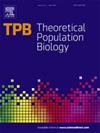穆勒棘轮和基因复制。
IF 1.3
4区 生物学
Q4 ECOLOGY
引用次数: 0
摘要
基因家族中基因的拷贝数在个体之间变化很大,并可能在几代之间继续变化。本文研究了与Haigh的Muller棘轮突变选择模型相关的复制-选择相互作用模型。新的基因拷贝通过复制产生,但随着拷贝数的增加,个体的适应度降低。我们的模型有两种形式:从单个模板复制副本或从任何现有副本复制副本。对于无限大小的种群,在两种情况下都存在重复选择平衡,并由移位泊松分布或负二项分布给出。除非受到协同上位的抵消,否则有限种群会因漂移而失去低拷贝数的单倍型,迫使它们进入一种被称为“逃逸进化”的机制,在这种机制中,新的拷贝在没有约束和平衡的情况下积累。我们讨论了几个经验例子,并根据我们的模型对它们进行了解释。一般来说,大的基因家族似乎过于分散,不适合单一模板模型,这表明一个动态的、可能加速的复制过程。本文章由计算机程序翻译,如有差异,请以英文原文为准。
Muller’s ratchet and gene duplication
Copy number of genes in gene families can be highly variable among individuals and may continue to change across generations. Here, we study a model of duplication–selection interaction, which is related to Haigh’s mutation–selection model of Muller’s ratchet. New gene copies are generated by duplication but fitness of individuals decreases as copy number increases. Our model comes in two flavors: duplicates are copied either from a single template or from any existing copy. A duplication–selection equilibrium exists in both cases for infinite size populations and is given by a shifted Poisson or a negative binomial distribution. Unless counteracted by synergistic epistasis, finite populations suffer from loss of low copy-number haplotypes by drift, forcing them into a regime called ‘run-away evolution’ in which new copies accumulate without bound nor equilibrium. We discuss a few empirical examples and interpret them in the light of our models. Generally, large gene families appear too over-dispersed to fit the single template model suggesting a dynamic, and potentially accelerating, duplication process.
求助全文
通过发布文献求助,成功后即可免费获取论文全文。
去求助
来源期刊

Theoretical Population Biology
生物-进化生物学
CiteScore
2.50
自引率
14.30%
发文量
43
审稿时长
6-12 weeks
期刊介绍:
An interdisciplinary journal, Theoretical Population Biology presents articles on theoretical aspects of the biology of populations, particularly in the areas of demography, ecology, epidemiology, evolution, and genetics. Emphasis is on the development of mathematical theory and models that enhance the understanding of biological phenomena.
Articles highlight the motivation and significance of the work for advancing progress in biology, relying on a substantial mathematical effort to obtain biological insight. The journal also presents empirical results and computational and statistical methods directly impinging on theoretical problems in population biology.
 求助内容:
求助内容: 应助结果提醒方式:
应助结果提醒方式:


